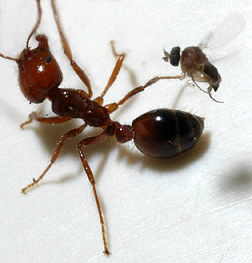This page has been archived and is being provided for reference purposes only. The page is no longer being updated, and therefore, links on the page may be invalid.
Read the magazine story to find out more. |
|
|
Controlling Red Imported Fire Ants Two Ways
By Sharon DurhamJuly 10, 2009
Two separate strategies for reducing the spread of red imported fire ants (RIFA) are being combined by Agricultural Research Service (ARS) scientists as part of a strategy that could potentially add to the arsenal against this spreading pest.
Currently, parasitic phorid flies are used in the United States to help control some fire ant populations. In Argentina, pathogens like Kneallhazia solenopsae and Vairimorpha invictae—alone or in combination—are associated with localized declines of 53 to 100 percent in fire ant populations, according to entomologist David Oi, at the ARS Center for Medical, Agricultural and Veterinary Entomology (CMAVE) in Gainesville, Fla.
Now, ARS scientists are looking to add a new scientific wrinkle: using the phorid fly as a vector for infecting the fire ant population with microsporidia.
Each phorid fly lays an egg into individual fire ants. These eggs later develop within the fire ant's head, ultimately causing its demise. But researchers tested a new method—infecting the phorid flies with a pathogenic microsporidia that controls fire ants.
Preliminary data showed that K. solenopsae was successfully transmitted to phorid flies without harming them. The next step is to determine whether infected flies are able to infect RIFA with the microsporidia, providing another mechanism for transmission between RIFA colonies.
According to Oi, K. solenopsae not only reduces fire ant colony size, it also reduces successful colony founding by reproducing ants, affects the survival of queens and increases the death rate of colonies.
Oi conducted this research with entomologists Sanford Porter and Steven Valles at CMAVE, and with Juan Briano and Luis Calcaterra of the ARS South American Biological Control Laboratory in Hurlingham, Argentina.
Read more about this research in the July 2009 issue of Agricultural Research magazine.
ARS is the U.S. Department of Agriculture's principal intramural scientific research agency.

